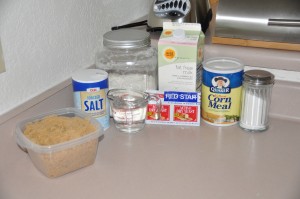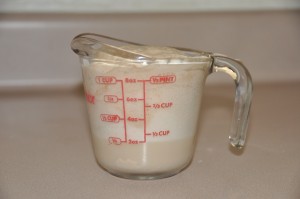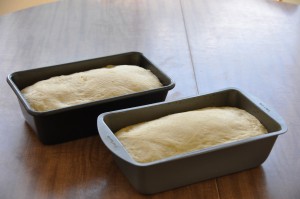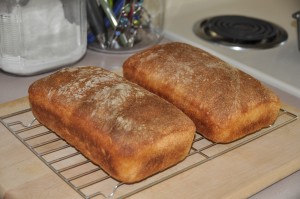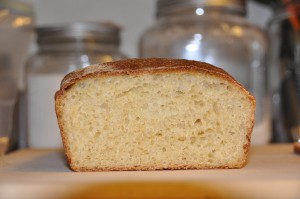“[Cornmeal Bread] makes a beautiful, well-risen loaf that should be thoroughly cooled before slicing. Don’t let the smell of it tempt you into cutting a big chunk off while it is still hot.”
-James Beard, Beard on Bread
I happened to wake up early this morning, so I decided to bake some bread. I settled on Cornmeal Bread because I had all the ingredients on hand (only having two eggs was a limiting factor).
Here are the ingredients:
The first step was to make some cornmeal mush with a cup of boiling water, a half cup of cornmeal, and some salt. Then I added the yeast and sugar to a half cup of water and let it proof. I don’t think I’ve ever had yeast proof so quickly–this is what it looked like after 2 minutes:
I started with only a half cup of water!
Everything was going smoothly as I combined all the ingredients and started adding the flour to the mixture, one cup at a time. At this point, I should make it clear that I am not a true morning person. I wake up early, but my heart just isn’t in it. Apparently, this means that my alertness level is somewhat lacking, because when I turned the dough onto my floured surface to begin kneading, I realized the “dough” was in reality the consistency of mud. There was no way to knead more flour into it–there was dough covering to my hands, stuck to the cutting board, still adhered to the bowl. I looked at the mess, briefly considered yelling loud enough to wake up Mike and have him help me scrape the dough off my hands, and then realized that the habit of kneading my dough on a cutting board instead of the counter was going to save the day. I tilted the cutting board over the bowl, and with the help of gravity and a knife, scraped all the dough back into the bowl. I somehow managed to turn on the faucet with my elbow, and washed the inch-thick layer of dough off my hands. Then I mixed in about a cup more flour, and finally had some bread dough I could actually work with. I still had to knead at least half a cup of flour into the dough to prevent it from sticking to the cutting board.
The moral of the story: always knead your dough on a cutting board instead of directly on the counter. If I had dumped that mess onto the kitchen counter, I would probably still be scraping it off.
The rest of my baking experience was non-eventful. I let the dough rise for about 45 minutes, formed it into loaves, and then let the loaves rise for about an hour.
Next, the loaves went into the oven for 10 minutes at 425 degrees, then 10 minutes at 350 degrees. Finally, I took the loaves out of the pans and baked them on the oven rack for 3 minutes to crisp the bottom of the loaves.
As Beard insists, we waited until the bread was cool before sampling it. I loved it–the bread had a spongy, soft texture and the taste was a perfect balance of sweet and salty. This is definitely a recipe I will make again; however, I have learned my lesson and will add more flour to the dough next time!

